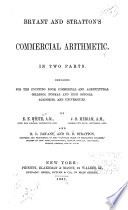 | Joseph Ray - Arithmetic - 1857 - 348 pages
...COMMON RULE FOR EQUATION OP PAYMENTS. Multiply each payment by the time to elapse till it becomes due; divide the sum of the products by the sum of the payments ; the quotient will be the equated time. When one of the payments is due on the day from which the equated time is... | |
 | Charles Guilford Burnham - 1857 - 342 pages
...75-7-15 = 5 months, the answer. Hence the RULE. Multiply each payment by the time when it becomes due, and divide the sum of the products by the sum of the payments, and the quotient will be the time required. 2. A merchant has owing him $420, to be paid as follows... | |
 | Charles Guilford Burnham - Arithmetic - 1857 - 328 pages
...5-4-15 = 5 months, the answer. Hence the ' RULE. Multiply each payment by the time when it becomes due, and divide the sum of the products by the sum of the payments, and the quotient will be the time required. 2. A merchant has owing him $420, to be paid as follows... | |
 | Horatio Nelson Robinson - Arithmetic - 1859 - 362 pages
...of 1 month on $180; and this equals a credit of 6 months on $30, because 30 X 6 = 180 X 1. RULE. I. Multiply each payment by its term of credit, and divide...products by the sum of the payments ; the quotient will be the average term of credit. II. Add the average term of credit to the date at which all the... | |
 | Horatio Nelson Robinson - Arithmetic - 1860 - 444 pages
...and 'this equals a credit of C months on $15, because 45 X 00 = 270 X 1. Hence the following RULE. I. Multiply each payment by its term of credit, and divide...products by the sum of the payments; the quotient will be the average term of credit. II. Add the average term of credit to the date at which all the... | |
 | Benjamin Greenleaf - Arithmetic - 1860 - 324 pages
...for the payment of the whole. Hence the following RULE. -—Multiply each payment by its own time, of credit, and divide the sum of the products by the sum of the payments. NOTE 1. — This is the rule usually adopted by merchants, but it is not perfectly correct ; for" if... | |
 | Benjamin Greenleaf - Arithmetic - 1860 - 456 pages
...payment to be 43 days, nearly, from May 1, or on June 13. RULE. — Multiply each payment by its own time of credit, and divide the sum of the products by the sum of the payments. NOTE 1. — When the date of the average time of payment is required, as in Example 2, Jind the time... | |
 | Charles Davies - Arithmetic - 1861 - 496 pages
...find the average time of payment : Rule. — Multiply each payment by the time before it becomes due, and divide the sum of the products by the sum of the payments: the Quotient will be the average time. Examples. 1. A merchant ows $1200, of which $200 is to be paid in 4 months,... | |
 | Education - 1861 - 712 pages
...at the starting point. The rule for Equation of Payments is, " multiply each payment by its own time of credit, and divide the sum of the products by the sum of the payments," — another case in point. I have put down some of the more prominent faults in the books, frankly... | |
 | Emerson Elbridge White - Arithmetic (Commercial), 1861 - 1861 - 348 pages
...hundredths of 9600 months=8 months, the equated time. RULE. — Multiply each payment or debt by its time of credit, and divide the sum of the PRODUCTS by the sum of the PAYMENTS. Note. — 1. By the term discount, as used above, is meant mercantile discount or simple interest.... | |
| |